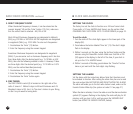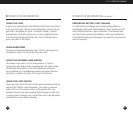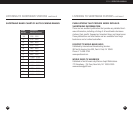
12 SHORTWAVE LISTENING GUIDE
32
UNDERSTANDING SHORTWAVE BANDS:
THE KEY TO ENJOYING YOUR SHORTWAVE RADIO
Introduction
Now that you have a shortwave radio, no doubt you’ll want to hear
worldwide stations right away. If you’re new to shortwave, please take
some time to learn the basics outlined below. To successfully listen to
shortwave stations you must know how to find them.They are found
in the shortwave bands. If you’re an experienced shortwave listener,
you’ll know what bands are and how to use them, but if you’re new,
you’ll need to learn about bands first.After that, you will have excellent
success. Please read on.
WHAT ARE BANDS? To fully enjoy shortwave listening,
this is the most important concept to learn right away.
If you have ever listened to AM or FM radio, then you already know
what a band is. The AM band is a frequency range stretching form
530 to 1600 kilohertz, the FM band is 66-108 megahertz.A band is
simply a frequency range where stations are located.When you look
for stations in these “bands”, you simply tune around with your tuning
buttons (or the tuning knob on an analog radio) until you find a station
you like. Shortwave is similar and the shortwave bands have names
like 25 meters, 31 meters, 49 meters, etc.These are abbreviated 25m,
31m and 49m. Just like in AM and FM radio, one simply gets into the
shortwave band and tunes around, looking for stations.
For example, the 19 meter shortwave band encompasses the frequency
range of 15100 to 15600 kilohertz. In the chart below is a list of the
shortwave bands used for international shortwave broadcasts and their
corresponding frequency ranges. Since some radios show frequency in
megahertz and some in kilohertz, both are shown here. Look at your
radio’s tuning scale or digital display (or owner’s manual) to determine
which frequency designation it uses in shortwave. Most radios use the
abbreviations KHz and MHz. On some shortwave radios these frequencies
will look like 15100 KHz, 15105 KHz or 15110 KHz, but on other
radios they might look like this: 15.1 MHz, 15.105 MHz or 15.11 MHz.
That’s because some radios show frequencies as kilohertz and others
show the frequencies as megahertz, as in the accompanying table. The
exact frequency ranges for these bands may vary somewhat from one
radio model to another. This is perfectly OK. On some radios the bands
are clearly marked, on others they are not marked at all. If it is not
apparent how to get into a band on your radio, consult the owner’s
manual, the etón Corporation web site (www.etoncorp.com) or contact
etón Corporation and we’ll show you how this is done for your model.
A HELPFUL ANALOGY: a shortwave band is like a street
with many individual addresses on it.
Think of a shortwave band as you would a street with a full range of
individual addresses on it, each address is a specific frequency. The 19
meter band could be called 19 Meter Street.As on any street, we have
a range of addresses encompassing individual house numbers such as
15100, 15105, 15110, etc., each of these house numbers representing
an individual house that you could visit on the street. In the 19 meter
shortwave band, these ‘addresses’ or ‘house numbers’ are called
frequencies and on each frequency you might visit a different short-
wave radio station.
SHORTWAVE LISTENING GUIDE continued
33
E100 OPERATION MANUAL


















